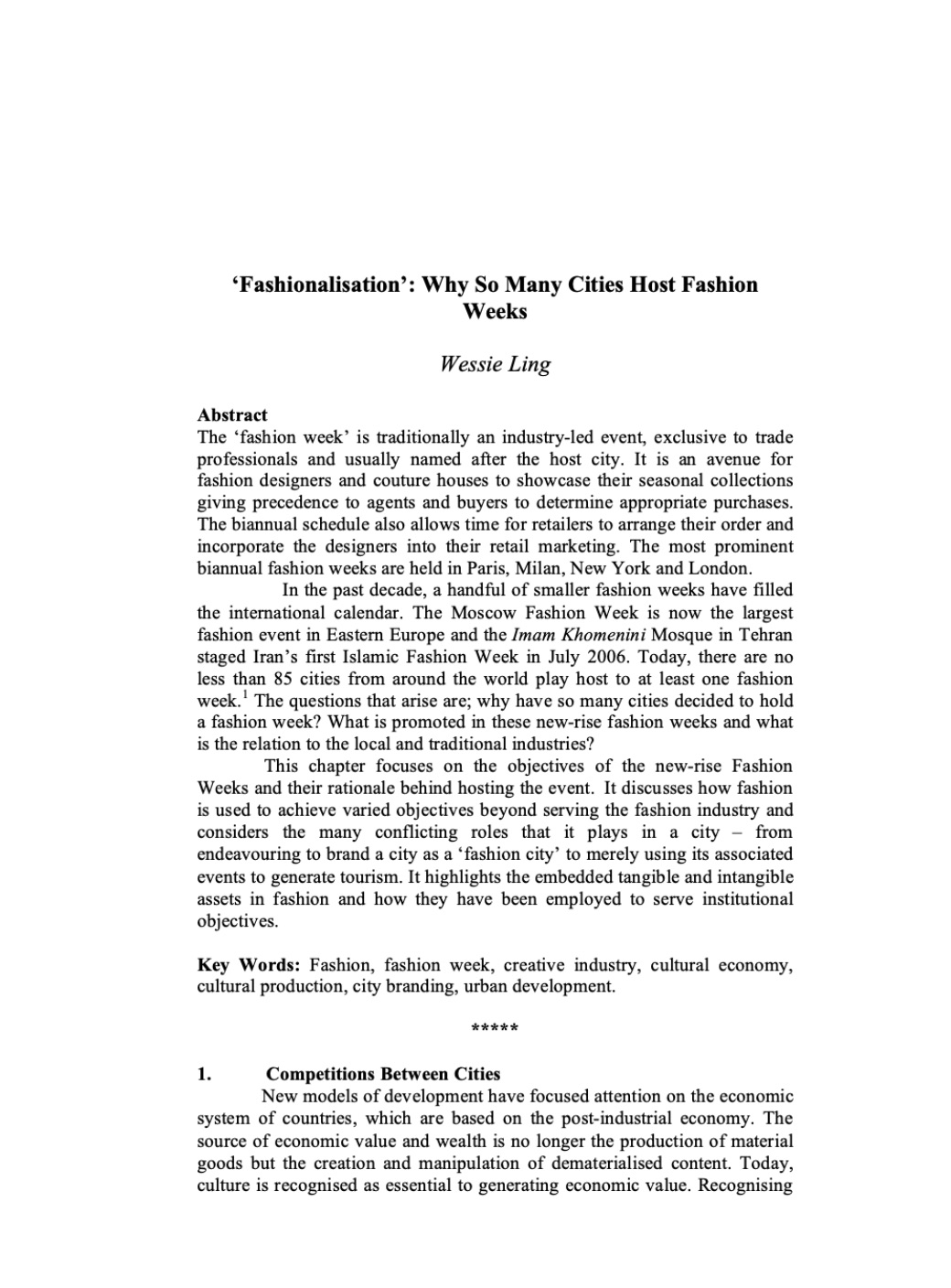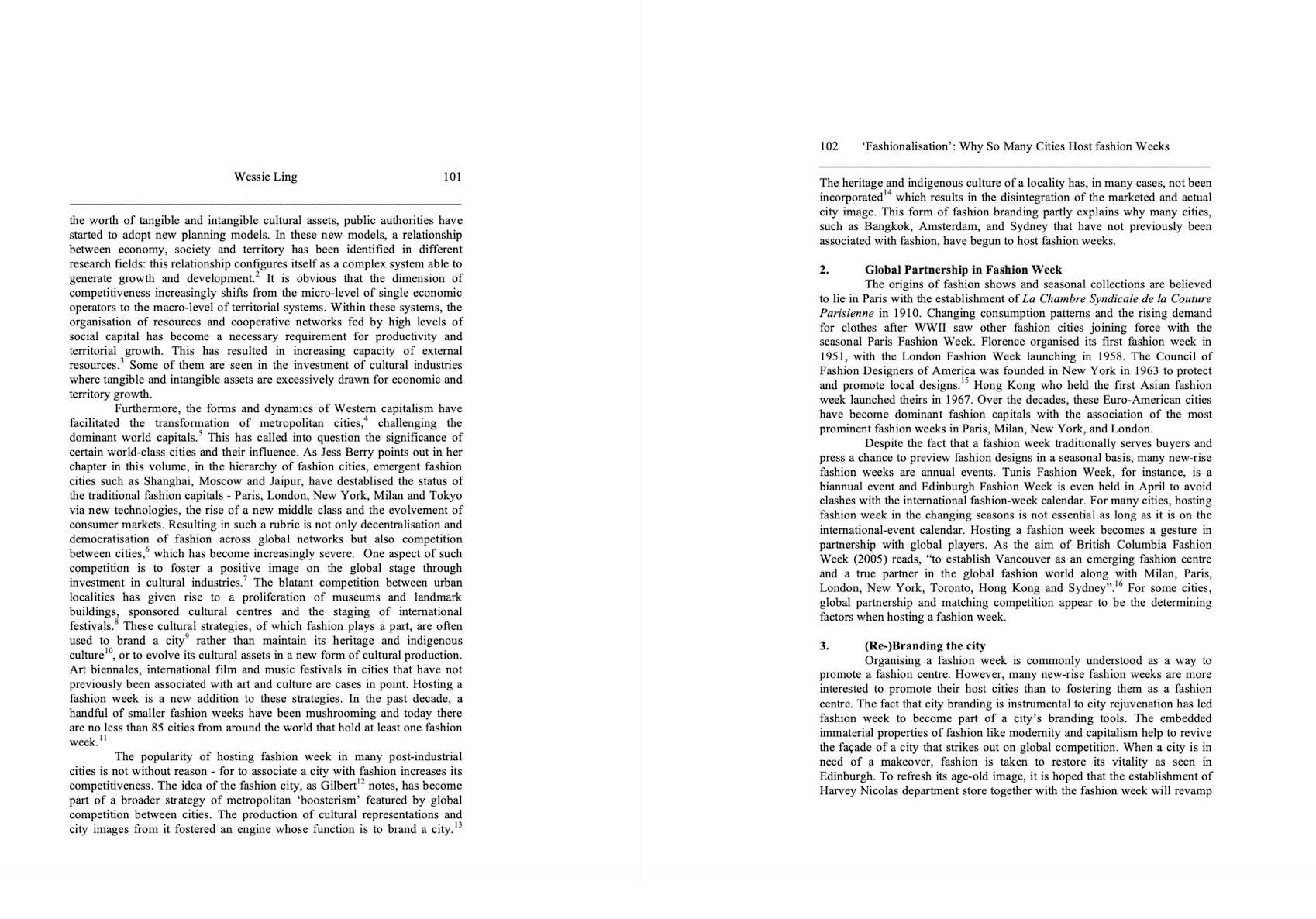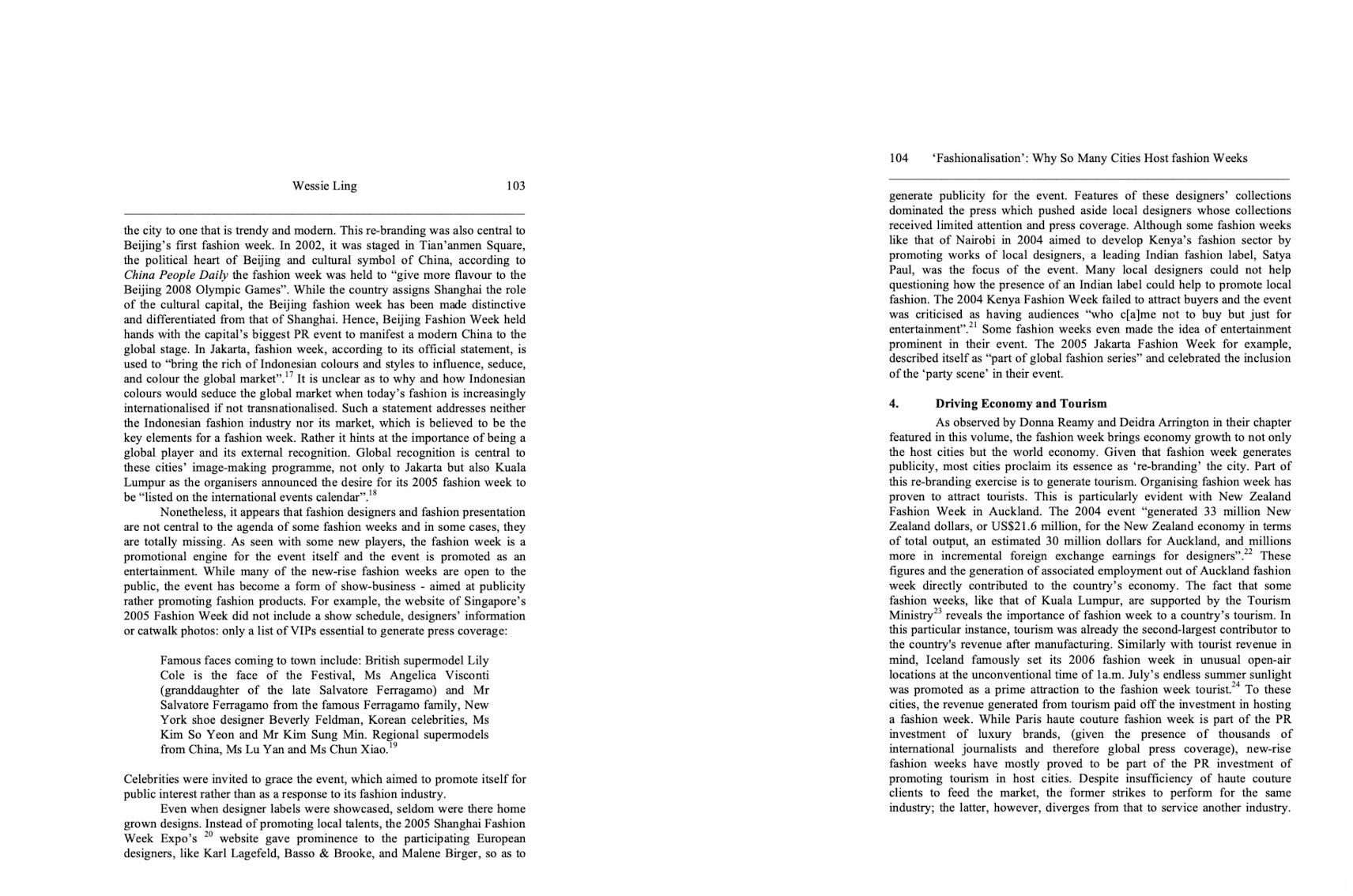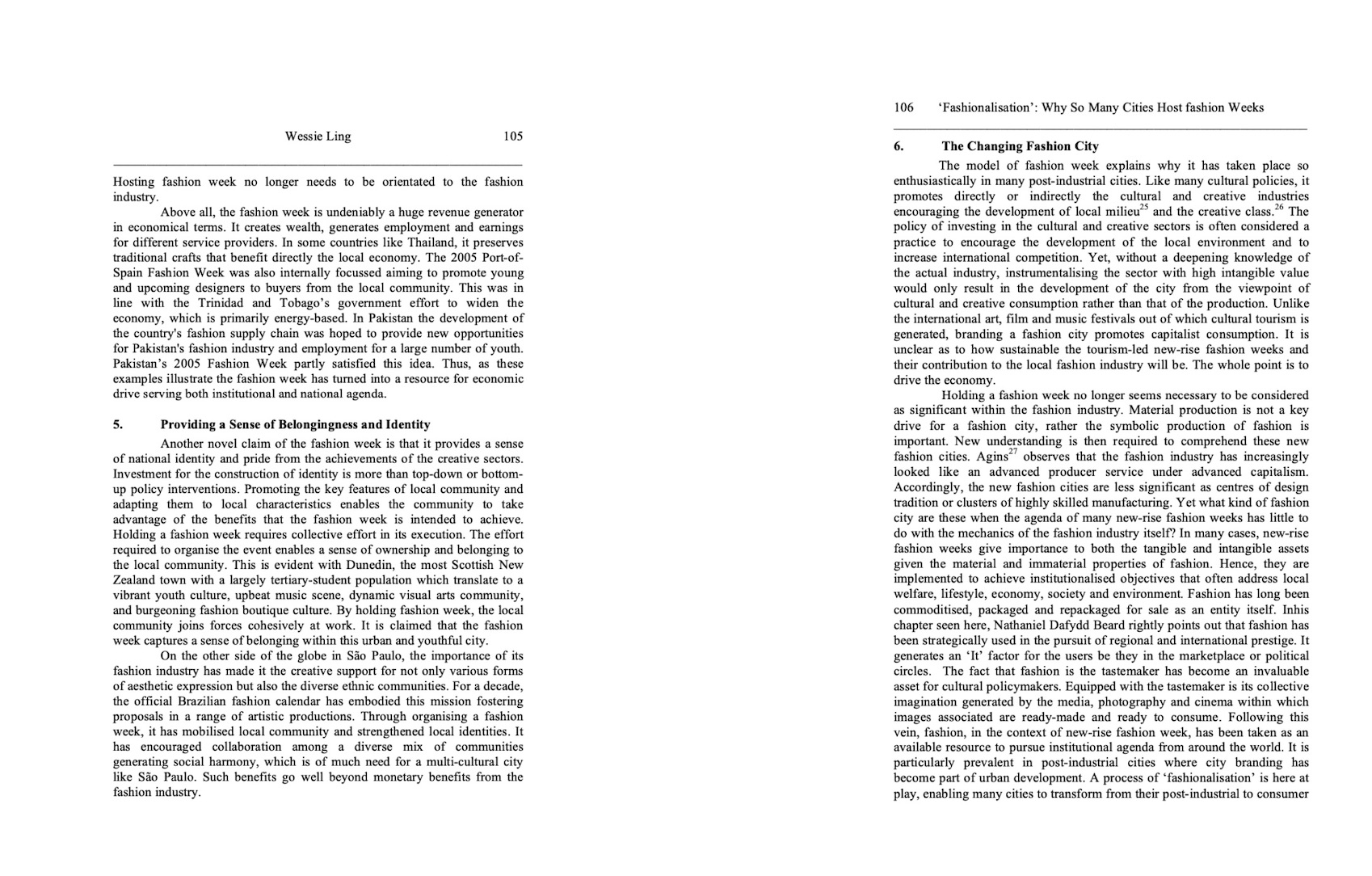Hello professors, I don't know how to do it and my stuck on this article below. First of all, I already know that the author
Hello professors,
I don't know how to do it and my stuck on this article below.
First of all, I already know that the author conceptually supports the objective of the study by utilizing the secondary sources by highlighting the embedded tangible and intangible assets in a fashion that are employed to serve the city objectives. However, I don't know what theoretical gaps are being filled in?
Also, concerning the results, I couldn't find the major results (including the major avenue results for future research) & the limits of this study.
Thanks you for considering my questions,
Have a nice day
'Fashionalisation': Why So Many Cities Host Fashion Weeks Wessie Ling Abstract The 'fashion week' is traditionally an industry-led event, exclusive to trade professionals and usually named after the host city. It is an avenue for fashion designers and couture houses to showcase their seasonal collections giving precedence to agents and buyers to determine appropriate purchases. The biannual schedule also allows time for retailers to arrange their order and incorporate the designers into their retail marketing. The most prominent biannual fashion weeks are held in Paris, Milan, New York and London. In the past decade, a handful of smaller fashion weeks have lled the international calendar. The Moscow Fashion Week is now the largest fashion event in Eastern Europe and the Imam Khomeuini Mosque in Tehran staged Iran's rst Islamic Fashion Week in July 2006. Today, there are no less than 85 cities from around the world play host to at least one fashion week.' The questions that arise are; why have so many cities decided to hold a fashion week? What is promoted in these new-rise fashion weeks and what is the relation to the local and traditional industries? This chapter focuses on the objectives of the new-rise Fashion Weeks and their rationale behind hosting the event. It discusses how fashion is used to achieve varied objectives beyond serving the fashion industry and considers the many conicting roles that it plays in a city from endeavouring to brand a city as a 'fashion city' to merely using its associated events to generate tourism. It highlights the embedded tangible and intangible assets in fashion and how they have been employed to serve institutional objectives. Key Words: Fashion, fashion week, creative industry, cultural economy, cultural production, city branding, urban development. **l** l. Competitions Between Cities New models of development have focused attention on the economic system of countries, which are based on the post-industrial economy. The source of economic value and wealth is no longer the production of material goods but the creation and manipulation of dematerialised content. Today, culture is recognised as essential to generating economic value. Recognising 102 'Fashionalisation': Why So Many Cities Host fashion Weeks Wessie Ling 101 The heritage and indigenous culture of a locality has, in many cases, not been incorporated" which results in the disintegration of the marketed and actual the worth of tangible and intangible cultural assets, public authorities have city image. This form of fashion branding partly explains why many cities, started to adopt new planning models. In these new models, a relationship such as Bangkok, Amsterdam, and Sydney that have not previously been between economy, society and territory has been identified in different associated with fashion, have begun to host fashion weeks. research fields: this relationship configures itself as a complex system able to generate growth and development." It is obvious that the dimension of 2. Global Partnership in Fashion Week competitiveness increasingly shifts from the micro-level of single economic The origins of fashion shows and seasonal collections are believed operators to the macro-level of territorial systems. Within these systems, the to lie in Paris with the establishment of La Chambre Syndicale de la Couture organisation of resources and cooperative networks fed by high levels of Parisienne in 1910. Changing consumption patterns and the rising demand social capital has become a necessary requirement for productivity and for clothes after WWII saw other fashion cities joining force with the territorial growth. This has resulted in increasing capacity of external seasonal Paris Fashion Week. Florence organised its first fashion week in resources." Some of them are seen in the investment of cultural industries 1951, with the London Fashion Week launching in 1958. The Council of where tangible and intangible assets are excessively drawn for economic and Fashion Designers of America was founded in New York in 1963 to protect territory growth and promote local designs. " Hong Kong who held the first Asian fashion Furthermore, the forms and dynamics of Western capitalism have week launched theirs in 1967. Over the decades, these Euro-American cities facilitated the transformation of metropolitan cities," challenging the have become dominant fashion capitals with the association of the most dominant world capitals." This has called into question the significance of prominent fashion weeks in Paris, Milan, New York, and London. certain world-class cities and their influence. As Jess Berry points out in her Despite the fact that a fashion week traditionally serves buyers and chapter in this volume, in the hierarchy of fashion cities, emergent fashion press a chance to preview fashion designs in a seasonal basis, many new-rise cities such as Shanghai, Moscow and Jaipur, have destablised the status of fashion weeks are annual events. Tunis Fashion Week, for instance, is a the traditional fashion capitals - Paris, London, New York, Milan and Tokyo biannual event and Edinburgh Fashion Week is even held in April to avoid via new technologies, the rise of a new middle class and the evolvement of clashes with the international fashion-week calendar. For many cities, hosting consumer markets. Resulting in such a rubric is not only decentralisation and fashion week in the changing seasons is not essential as long as it is on the democratisation of fashion across global networks but also competition international-event calendar. Hosting a fashion week becomes a gesture in between cities," which has become increasingly severe. One aspect of such partnership with global players. As the aim of British Columbia Fashion competition is to foster a positive image on the global stage through Week (2005) reads, "to establish Vancouver as an emerging fashion centre investment in cultural industries.' The blatant competition between urban and a true partner in the global fashion world along with Milan, Paris, localities has given rise to a proliferation of museums and landmark London, New York, Toronto, Hong Kong and Sydney". " For some cities, buildings, sponsored cultural centres and the staging of international global partnership and matching competition appear to be the determining festivals. These cultural strategies, of which fashion plays a part, are often factors when hosting a fashion week used to brand a city" rather than maintain its heritage and indigenous culture , or to evolve its cultural assets in a new form of cultural production. 3. (Re-)Branding the city Art biennales, international film and music festivals in cities that have not Organising a fashion week is commonly understood as a way to previously been associated with art and culture are cases in point. Hosting a promote a fashion centre. However, many new-rise fashion weeks are more fashion week is a new addition to these strategies. In the past decade, a interested to promote their host cities than to fostering them as a fashion handful of smaller fashion weeks have been mushrooming and today there centre. The fact that city branding is instrumental to city rejuvenation has led are no less than 85 cities from around the world that hold at least one fashion fashion week to become part of a city's branding tools. The embedded week. "! immaterial properties of fashion like modernity and capitalism help to revive The popularity of hosting fashion week in many post-industrial the facade of a city that strikes out on global competition. When a city is in cities is not without reason - for to associate a city with fashion increases its need of a makeover, fashion is taken to restore its vitality as seen in competitiveness. The idea of the fashion city, as Gilbert" notes, has become Edinburgh. To refresh its age-old image, it is hoped that the establishment of part of a broader strategy of metropolitan "boosterism' featured by global Harvey Nicolas department store together with the fashion week will revamp competition between cities. The production of cultural representations and city images from it fostered an engine whose function is to brand a city.104 'Fashionalisation': Why So Many Cities Host fashion Weeks Wessie Ling 103 generate publicity for the event. Features of these designers' collections dominated the press which pushed aside local designers whose collections the city to one that is trendy and modern. This re-branding was also central to received limited attention and press coverage. Although some fashion weeks Beijing's first fashion week. In 2002, it was staged in Tiananmen Square, like that of Nairobi in 2004 aimed to develop Kenya's fashion sector by the political heart of Beijing and cultural symbol of China, according to promoting works of local designers, a leading Indian fashion label, Satya China People Daily the fashion week was held to "give more flavour to the Paul, was the focus of the event. Many local designers could not help Beijing 2008 Olympic Games". While the country assigns Shanghai the role questioning how the presence of an Indian label could help to promote local of the cultural capital, the Beijing fashion week has been made distinctive fashion. The 2004 Kenya Fashion Week failed to attract buyers and the event and differentiated from that of Shanghai. Hence, Beijing Fashion Week held was criticised as having audiences "who came not to buy but just for hands with the capital's biggest PR event to manifest a modern China to the entertainment"." Some fashion weeks even made the idea of entertainment global stage. In Jakarta, fashion week, according to its official statement, is prominent in their event. The 2005 Jakarta Fashion Week for example, used to "bring the rich of Indonesian colours and styles to influence, seduce, described itself as "part of global fashion series" and celebrated the inclusion and colour the global market". It is unclear as to why and how Indonesian of the 'party scene' in their event. colours would seduce the global market when today's fashion is increasingly internationalised if not transnationalised. Such a statement addresses neither 4. Driving Economy and Tourism the Indonesian fashion industry nor its market, which is believed to be the As observed by Donna Reamy and Deidra Arrington in their chapter key elements for a fashion week. Rather it hints at the importance of being a featured in this volume, the fashion week brings economy growth to not only global player and its external recognition. Global recognition is central to the host cities but the world economy. Given that fashion week generates these cities' image-making programme, not only to Jakarta but also Kuala publicity, most cities proclaim its essence as 're-branding' the city. Part of Lumpur as the organisers announced the desire for its 2005 fashion week to this re-branding exercise is to generate tourism. Organising fashion week has be "listed on the international events calendar". proven to attract tourists. This is particularly evident with New Zealand Nonetheless, it appears that fashion designers and fashion presentation Fashion Week in Auckland. The 2004 event "generated 33 million New are not central to the agenda of some fashion weeks and in some cases, they Zealand dollars, or US$21.6 million, for the New Zealand economy in terms are totally missing. As seen with some new players, the fashion week is a of total output, an estimated 30 million dollars for Auckland, and millions promotional engine for the event itself and the event is promoted as an more in incremental foreign exchange earnings for designers"." These entertainment. While many of the new-rise fashion weeks are open to the figures and the generation of associated employment out of Auckland fashion public, the event has become a form of show-business - aimed at publicity week directly contributed to the country's economy. The fact that some rather promoting fashion products. For example, the website of Singapore's fashion weeks, like that of Kuala Lumpur, are supported by the Tourism 2005 Fashion Week did not include a show schedule, designers' information Ministry" reveals the importance of fashion week to a country's tourism. In or catwalk photos: only a list of VIPs essential to generate press coverage: this particular instance, tourism was already the second-largest contributor to the country's revenue after manufacturing. Similarly with tourist revenue in Famous faces coming to town include: British supermodel Lily mind, Iceland famously set its 2006 fashion week in unusual open-air Cole is the face of the Festival, Ms Angelica Visconti locations at the unconventional time of la.m. July's endless summer sunlight (granddaughter of the late Salvatore Ferragamo) and Mr was promoted as a prime attraction to the fashion week tourist." To these Salvatore Ferragamo from the famous Ferragamo family, New cities, the revenue generated from tourism paid off the investment in hosting York shoe designer Beverly Feldman, Korean celebrities, Ms a fashion week. While Paris haute couture fashion week is part of the PR Kim So Yeon and Mr Kim Sung Min. Regional supermodels investment of luxury brands, (given the presence of thousands of from China, Ms Lu Yan and Ms Chun Xiao." international journalists and therefore global press coverage), new-rise fashion weeks have mostly proved to be part of the PR investment of Celebrities were invited to grace the event, which aimed to promote itself for promoting tourism in host cities. Despite insufficiency of haute couture public interest rather than as a response to its fashion industry. clients to feed the market, the former strikes to perform for the same Even when designer labels were showcased, seldom were there home industry; the latter, however, diverges from that to service another industry. grown designs. Instead of promoting local talents, the 2005 Shanghai Fashion Week Expo's website gave prominence to the participating European designers, like Karl Lagefeld, Basso & Brooke, and Malene Birger, so as to106 'Fashionalisation': Why So Many Cities Host fashion Weeks Wessie Ling 105 The Changing Fashion City The model of fashion week explains why it has taken place so Hosting fashion week no longer needs to be orientated to the fashion enthusiastically in many post-industrial cities. Like many cultural policies, it industry. promotes directly or indirectly the cultural and creative industries Above all, the fashion week is undeniably a huge revenue generator encouraging the development of local milieu" and the creative class." The in economical terms. It creates wealth, generates employment and earnings policy of investing in the cultural and creative sectors is often considered a for different service providers. In some countries like Thailand, it preserves practice to encourage the development of the local environment and to traditional crafts that benefit directly the local economy. The 2005 Port-of- increase international competition. Yet, without a deepening knowledge of Spain Fashion Week was also internally focussed aiming to promote young the actual industry, instrumentalising the sector with high intangible value and upcoming designers to buyers from the local community. This was in line with the Trinidad and Tobago's government effort to widen the would only result in the development of the city from the viewpoint of cultural and creative consumption rather than that of the production. Unlike economy, which is primarily energy-based. In Pakistan the development of the international art, film and music festivals out of which cultural tourism is the country's fashion supply chain was hoped to provide new opportunities for Pakistan's fashion industry and employment for a large number of youth. generated, branding a fashion city promotes capitalist consumption. It is unclear as to how sustainable the tourism-led new-rise fashion weeks and Pakistan's 2005 Fashion Week partly satisfied this idea. Thus, as these examples illustrate the fashion week has turned into a resource for economic their contribution to the local fashion industry will be. The whole point is to drive the economy. drive serving both institutional and national agenda. Holding a fashion week no longer seems necessary to be considered as significant within the fashion industry. Material production is not a key 5. Providing a Sense of Belongingness and Identity drive for a fashion city, rather the symbolic production of fashion is Another novel claim of the fashion week is that it provides a sense important. New understanding is then required to comprehend these new of national identity and pride from the achievements of the creative sectors. fashion cities. Agins observes that the fashion industry has increasingly Investment for the construction of identity is more than top-down or bottom- looked like an advanced producer service under advanced capitalism. up policy interventions. Promoting the key features of local community and Accordingly, the new fashion cities are less significant as centres of design adapting them to local characteristics enables the community to take tradition or clusters of highly skilled manufacturing. Yet what kind of fashion advantage of the benefits that the fashion week is intended to achieve. city are these when the agenda of many new-rise fashion weeks has little to Holding a fashion week requires collective effort in its execution. The effort do with the mechanics of the fashion industry itself? In many cases, new-rise required to organise the event enables a sense of ownership and belonging to fashion weeks give importance to both the tangible and intangible assets the local community. This is evident with Dunedin, the most Scottish New given the material and immaterial properties of fashion. Hence, they are Zealand town with a largely tertiary-student population which translate to a implemented to achieve institutionalised objectives that often address local vibrant youth culture, upbeat music scene, dynamic visual arts community, welfare, lifestyle, economy, society and environment. Fashion has long been and burgeoning fashion boutique culture. By holding fashion week, the local commoditised, packaged and repackaged for sale as an entity itself. Inhis community joins forces cohesively at work. It is claimed that the fashion chapter seen here, Nathaniel Dafydd Beard rightly points out that fashion has week captures a sense of belonging within this urban and youthful city. been strategically used in the pursuit of regional and international prestige. It On the other side of the globe in Sao Paulo, the importance of its generates an 'It' factor for the users be they in the marketplace or political fashion industry has made it the creative support for not only various forms circles. The fact that fashion is the tastemaker has become an invaluable of aesthetic expression but also the diverse ethnic communities. For a decade, asset for cultural policymakers. Equipped with the tastemaker is its collective the official Brazilian fashion calendar has embodied this mission fostering imagination generated by the media, photography and cinema within which proposals in a range of artistic productions. Through organising a fashion mages associated are ready-made and ready to consume. Following this week, it has mobilised local community and strengthened local identities. It has encouraged collaboration among a diverse mix of communities vein, fashion, in the context of new-rise fashion week, has been taken as an available resource to pursue institutional agenda from around the world. It is generating social harmony, which is of much need for a multi-cultural city like Sao Paulo. Such benefits go well beyond monetary benefits from the particularly prevalent in post-industrial cities where city branding has become part of urban development. A process of "fashionalisation' is here at fashion industry. play, enabling many cities to transform from their post-industrial to consumerWealie Ling 10? stage. Fashion week is instrumental to their growth and development constituting an identity for which they are so in need. The real value of the fashion week is then connected to the perception of the event from which emerges an image linked intrinsically to the new city's facade in the world stage. In sum, the tangible and intangible assets of the fashion week together with its generated image constitute and distinguish the city in the context of global competition. Competition between cities, observes Massey\" and Sassen29 encourages a hierarchical reordering of cities across the planet. Agins further coined the phrase 'the end of fashion' and acutely points to the upsetting hierarchy of fashion cities across the globe challenging the dominant players in trend endorsement. As such, is there a reordering of ishion cities across the globe and, if so, to what extent? In the event of the new-rise fashion weeks, none of them (as of today) appears to override that of key fashion capitals. The dominant fashion weeks of Paris, Milan and New York for example, continue to legitimate designers, endorsing new creations. Their unchanging power saw the continual venture of young Japanese designers to Paris Fashion Week for legitimacy despite Tokyo's crowned fashion capital status.\" The proliferation of fashion weeks across the globe only irther enforces the legitimacy of the dominant players. One can easily appear in a local fashion week, while showing in one of the dominant fashion capitals would require additional effort, external endorsement and increase investment. Seldom do new-rise fashion weeks dominate key fashion magazines in their seasonal issues, like the major fashion weeks do. Designers under the phenomenon of global fashion week are rather seen as the victims of the system as many new-rise fashion weeks have no roots in fashion production, let alone promotion of thu. The rise of new fashion cities may well have promoted alternative ways of creative practice and routes to succeed in the fashion industry. Their vibrancy evidently promotes diversity in fashion styles and trends, however only to a certain extent. The fact that the objectives of many new-rise fashion weeks are intrinsically linked to city branding and the economy transforms the role of the fashion week. Given that fashion is a resource with fashion week being one of its devices, it becomes enslaved by state and institutional agendas. While some new-rise fashion weeks not as a solvent to the host cities' internal affairs, the fashion week contest would be a long march for many new hosts to succeed locally and globally











